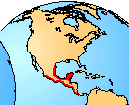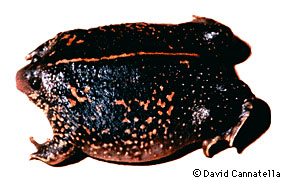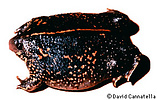Rhinophrynidae
David Cannatella


This tree diagram shows the relationships between several groups of organisms.
The root of the current tree connects the organisms featured in this tree to their containing group and the rest of the Tree of Life. The basal branching point in the tree represents the ancestor of the other groups in the tree. This ancestor diversified over time into several descendent subgroups, which are represented as internal nodes and terminal taxa to the right.

You can click on the root to travel down the Tree of Life all the way to the root of all Life, and you can click on the names of descendent subgroups to travel up the Tree of Life all the way to individual species.
For more information on ToL tree formatting, please see Interpreting the Tree or Classification. To learn more about phylogenetic trees, please visit our Phylogenetic Biology pages.
close boxIntroduction
The Mexican Burrowing Toad (Rhinophrynus dorsalis) is the only living member of this family. It is one of the strangest of frogs. This animal is highly fossorial (adapted for burrowing) and apparently only comes to the surface to breed, and then only during very heavy rains. The head is small and cone-shaped, and not surprisingly, the skull resembles that of a mole (Spalax). The skin is quite thick, and an early naturalist described the frog (in French) as a bag of bones. It ranges through southern Rio Grande Valley of Texas to Costa Rica. This frog is 5-7 cm long. There is usually a broad red or orange stripe down the middle of the back. There is a spade, used for digging, on the inner edge of the foot; the first toe is also modified to extend the functional edge of the spade.
Rhinophrynus is specialized for eating termites, and the tongue seems to be particularly modified for this activity. Instead of being flipped out over itself, as in most frogs, the tongue is projected straight out of the mouth (Trueb, 1983).
Many small eggs are laid in water, and the tadpoles aggregate and form large schools. They are specialized for filter-feeding on small particles suspended in the water, rather than grazing on algae or eating detritus from the bottom of the pond. Correlated with this behavior, the larvae lack beaks and denticles; they also have paired spiracles like most pipid tadpoles. This type of tadpole (Orton Type 1) is evidence of a close phylogenetic relationship between Rhinophrynidae and Pipidae. The larger group to which these two families, and the fossil family Palaeobatrachidae, belong is called the Pipoidea.
Geographic Distribution
The distribution of living members of the family Rhinophrynidae is indicated in red. image info
image info
Discussion of Phylogenetic Relationships
Definition of the name Rhinophrynidae and thus a listing of synapomorphies for the taxon is problematic because name Rhinophrynidae has been applied consistently to several fossil taxa (Henrici, 1991) that are related to the single living taxon dorsalis. Association of the name Rhinophrynidae or even Rhinophrynus with living taxa only would render those names redundant with the name of the living species. Because the living taxon has a widely used name, we use the more inclusive names Rhinophrynus and Rhinophrynidae for taxa that incorporate fossils. This also has the advantage of stabilizing those names with their common usage. Therefore, Rhinophrynidae is defined to be a stem-based name for those pipoids that are more closely related to the taxon dorsalis than to †Palaeobatrachidae + Pipidae. Rhinophrynus is defined as a stem-based name for rhinophrynids that are more closely related to the living taxon dorsalis than to †Eorhinophrynus or †Chelomophrynus.
By this definition, synapomorphies of Rhinophrynidae include (1) the division of the distal condyle of the femur into lateral and medial condyles, (Henrici, 1991), and three others that we derived from Henrici's work: (2) modification of the prehallux and distal phalanx of the first digit into a spade for digging, (3) tibiale and fibulare short and stocky, with distal ends fused, and (4) an elongate (at least as long as wide) atlantal neural arch. The first three of these are unknown in †Eorhinophrynus. Synapomorphies of Rhinophrynus are given by Henrici (1991).
Maxson and Daugherty (1980) reported MC'F distances of 170 between Ascaphus and Rhinophrynus dorsalis, more than 190 between Rhinophrynus and Bombina, and more than 200 between Rhinophrynus and Xenopus, Scaphiopus, Pelobates, and three neobatrachians. From these data they tentatively concluded that "... Rhinophrynus appears to have shared a common ancestor more recently with Ascaphus than with other salientian lineages..." (p. 279). This is in contrast to the conclusions reached by Cannatella (1985) and Hay et al. (1995).
References
Click here for general list of references
About This Page
David Cannatella
catfish@mail.utexas.edu
Section of Integrative Biology and Texas Memorial Museum, University of Texas, Austin, TX 78712
Correspondence regarding this page should be directed to David Cannatella at
catfish@mail.utexas.edu
Page copyright © 1995 David Cannatella
Citing this page:
Cannatella, David. 1995. Rhinophrynidae. Version 01 January 1995 (under construction). http://tolweb.org/Rhinophrynidae/16982/1995.01.01 in The Tree of Life Web Project, http://tolweb.org/







